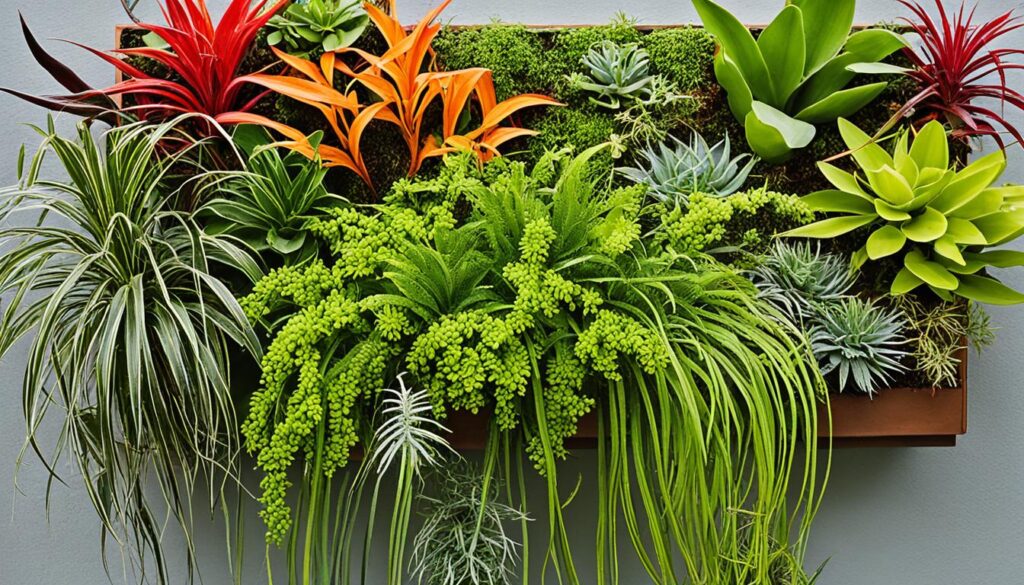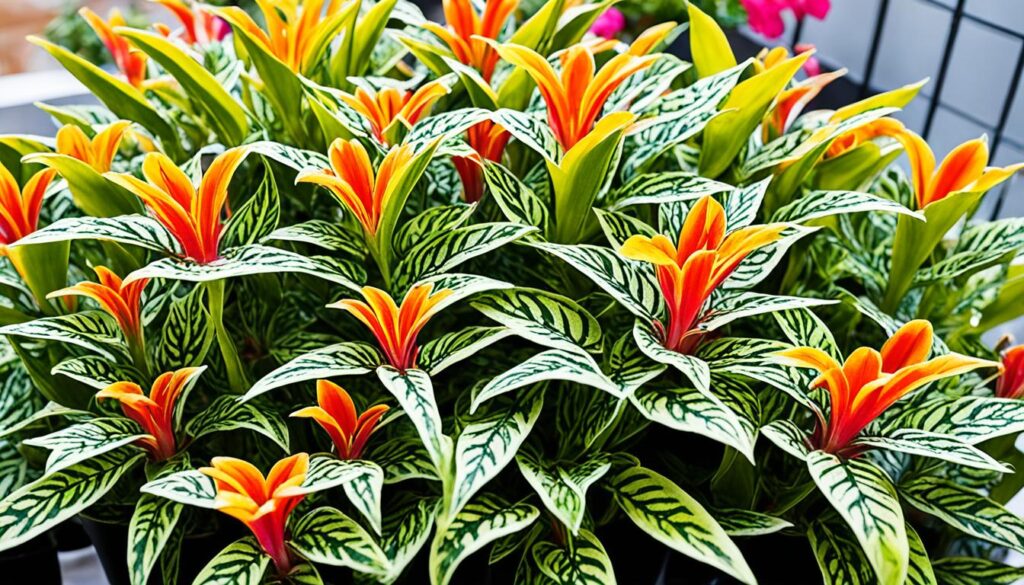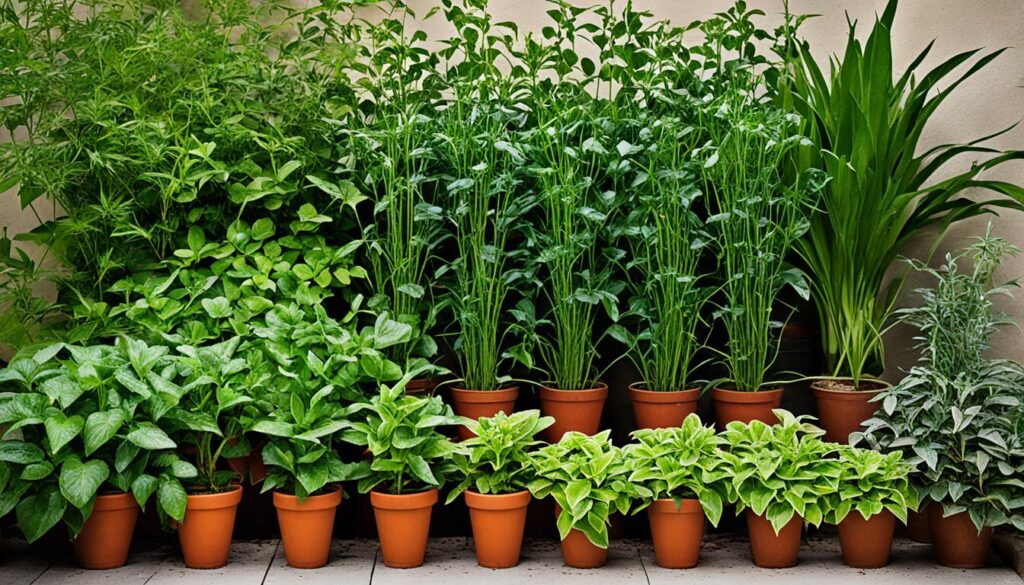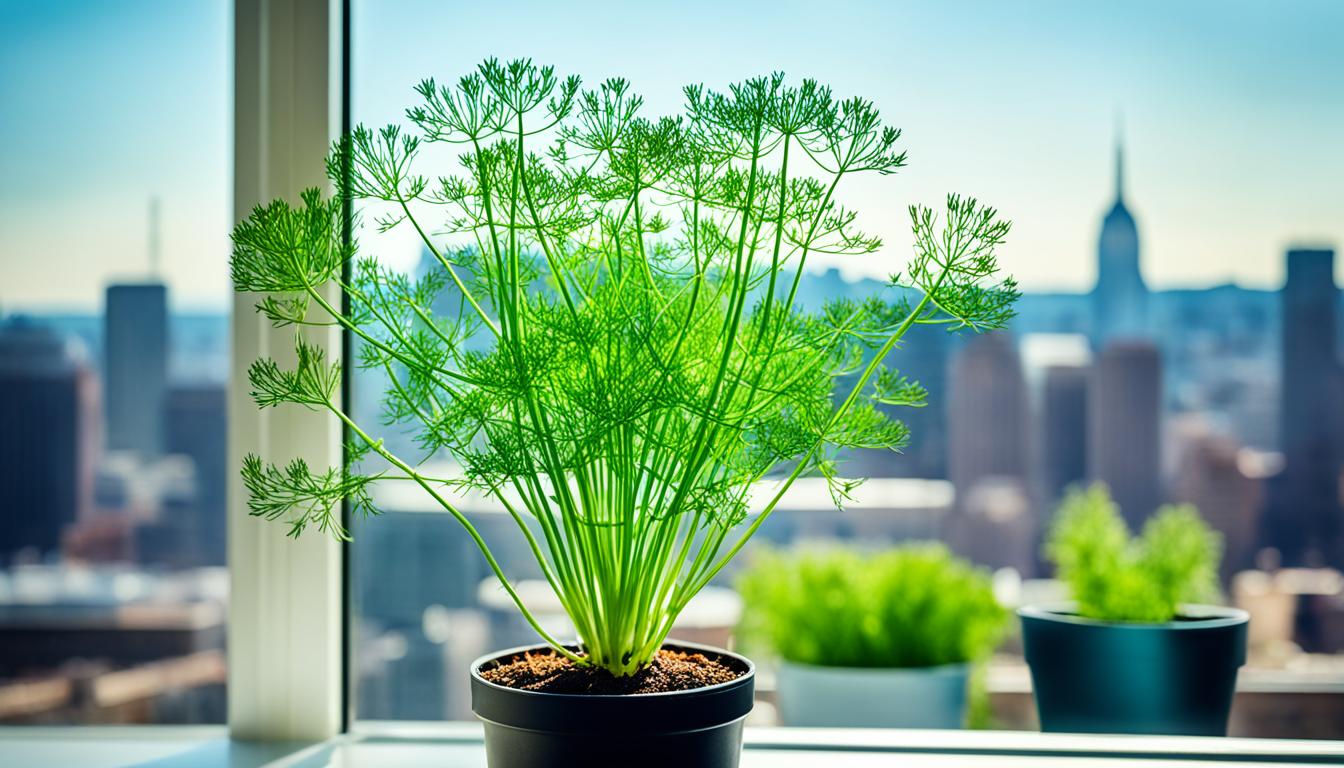Did you know that more city folks are starting gardens in their homes? It’s true!
It doesn’t matter if you have a tiny balcony, a bright window, or a little corner. You can start gardening too. Before you begin, it’s key to learn about different gardening terms. This guide will help you know and use these words. Then, you can be a great city gardener.
Key Takeaways:
- Apartment gardening is getting more popular with city people.
- It’s important to know gardening words to do well.
- This guide will help you learn what you need to have a lush garden at home.
Air Purifying
Air purifying plants make the air in your apartment better. They can take away toxins from the air. This makes the air healthier and your home looks nicer.
These plants cut down on indoor air pollution. They soak up bad stuff like formaldehyde and benzene. Having these plants makes your home safer and cleaner.
Plants also make more oxygen inside. They take in carbon dioxide and let out oxygen. This better air helps your brain, lowers stress, and makes you feel better.
Some great plants for clean air are the spider plant, snake plant, and peace lily. They look good and clean the air well.
Adding plants to your apartment is good for you. They clean the air and make your home feel fresh. Indoor plants make your living space healthier. Moreover, plants can boost your mood and enhance your concentration, creating a more productive atmosphere. To maximize these benefits, it’s helpful to optimize apartment plant placement, ensuring they receive the right amount of light and attention. By strategically positioning your plants throughout your living space, you can create a more harmonious and inviting environment.
Dormant
Dormancy is a time when plants rest in the winter. Their growth slows or stops. Apartment gardeners need to know this to care for plants right. During this time, plants need less water and food. Some might even lose their leaves. It’s key to change how much you water and feed them.
Winter dormancy helps plants save energy for spring. Even if we don’t see much happening, plants are busy inside. They slow down and rest. This rest is good for plants. It helps them grow better later.
Knowing about dormancy helps gardeners care for their plants. Each plant has different needs during this time. Some need cold, others don’t. It’s important to know what your plants need.
- Water less: Dormant plants don’t need much water. Too much can harm them. Check the soil before watering. Water only if the top inch is dry.
- Use less fertilizer: Dormant plants don’t grow much, so they don’t need lots of food. Use less fertilizer. You can fertilize more when you see new growth.
- Keep an eye on temperature: Some plants need cold to wake up. Make sure your place isn’t too warm for them. Watch the temperature to help your plants.
- Prune a bit: Now is a good time to cut off dead or damaged parts. This helps the plant look good and grow well later.
By knowing about dormancy, gardeners can keep their plants happy. This prepares them for beautiful growth in the future.
Epiphyte
Epiphytes are amazing plants. They grow on other plants, like trees, but don’t hurt them. They get water and food from the air or debris around them. This lets them live in tough places. Epiphytes are often seen in warm, tropical places. Many people like to grow them in their apartments.
Air plants, epiphytic ferns, bromeliads, and orchids are famous types of epiphytes. Air plants, or Tillandsia, need little care and look beautiful. Staghorn ferns hang on tree bark and look stunning. Colorful bromeliads, like Aechmea and Neoregelia, brighten any room. Orchids, such as Phalaenopsis and Dendrobium, have lovely flowers and smells.
Adding epiphytes can make your apartment look like a tropical paradise. They don’t need much room. They also look great and bring nature inside. Epiphytes are perfect for making your space beautiful.

| Epiphyte Plants | Description |
|---|---|
| Air Plants (Tillandsia) | Air plants are easy to take care of. They make any place look elegant. You can hang them on wood or put them in holders. |
| Epiphytic Ferns | Staghorn ferns attach to tree bark. They need light and humidity to grow well. They are great for apartment gardens. |
| Bromeliads | Bromeliads have bright, beautiful leaves. You can grow them on trees or in pots. They bring a tropical feel indoors. |
| Epiphytic Orchids | Orchids like Phalaenopsis and Dendrobium are lovely. They have beautiful flowers. You can grow them on bark or special mounts. |
Family
In the plant world, knowing groups is key. Plant families help us understand them. These families group plants with common traits and DNA links. This helps people who garden in apartments know how to care for their plants.
Knowing about a plant’s family helps you get their care right. You learn what each plant likes and what problems they might face. With this info, your plants will be healthier and grow better.
There are many plant families, each different in its own way. Let’s look at a few:
| Plant Family | Representative Species |
|---|---|
| Asteraceae | Daisies, sunflowers |
| Lamiaceae | Mint family |
| Rosaceae | Roses, strawberries |
Learning about plant families helps you know your plants better. It leads to better care decisions. You’ll understand their growth and needs, making your garden thrive.
Frond
Fronds are a special kind of leaf. They are found in ferns and palm trees. These leaves are big and divided, looking like feathers. Fronds help plants make food from sunlight.
Apartment gardeners need to know about fronds. This knowledge helps them care for different plants. Not all plants have fronds, though. Leaf shapes can be simple or complex.
This picture shows the beautiful frond of a palm tree. It highlights the variety of leaf types in nature.
Knowing about fronds and leaves helps gardeners. They can take better care of their plants. This ensures the plants grow well.
Genus
Genus is a key category in plant classification. It tells us about a group of similar species. Knowing a plant’s genus helps us understand its traits and how to take care of it. It also shows us what diseases or pests might be a problem. Plant names have the genus and species names, like Rosa spp. for roses. Here, Rosa is the genus.
Learning about a plant’s genus tells us how it grows and what it needs. This lets us take care of plants better. We can make sure they are healthy and happy.
For plants in the genus Calathea, I know they need lots of humidity and not too much light. I make their environment just right. I might mist them or use a humidifier.
Knowing the genus also tells me what problems a plant might have. For Rosa plants, they get fungal diseases like black spot. By taking care, like making sure they have air and not watering from above, I can keep them healthy.

| Genus | Characteristics | Care Needs |
|---|---|---|
| Calathea | Ornamental foliage, vibrant colors, patterns | High humidity, indirect light, well-draining soil |
| Rosa | Flowering shrubs, thorny stems, fragrant blooms | Full sun, well-draining soil, regular pruning |
| Spathiphyllum | Glossy, dark green leaves, white flowers | Low to medium light, moderate humidity, regular watering |
Gardeners in apartments can find many plants to grow. Each plant genus has its own needs and looks. This makes indoor gardens full of life and very interesting.
Hardy
Choosing hardy plants for apartment gardening is smart. They survive cold and require less care.
Hardy plants handle cold well and are very adaptable. They keep growing in cold winters or when the weather changes a lot.
The USDA Plant Hardiness Zone Map is useful. It shows the best plants for your area by checking winter temps.
| Benefits of Hardy Plants | Examples of Hardy Plants |
|---|---|
|
|
Plants like lavender and rosemary are hardy. They handle cold well, perfect for apartment gardens.
For a lovely garden all year, pick hardy plants. Look at your hardiness zone to find the best ones for your place. Your garden will look great, even in tough weather.
Humidity
Humidity is key for indoor plants’ health and growth. Each plant needs a different humidity level. Not enough humidity can make leaves dry and plants weak. Too much can cause fungus and root problems.
To manage humidity, apartment gardeners can:
- Mist plants to raise humidity around them
- Use humidifiers to keep the air moist
- Put plants together to make a moist microclimate
- Set plants near water trays to boost moisture
Keeping an eye on humidity helps plants grow strong. It also stops humidity-related issues.
Leggy
Leggy plants have long stems. This is a big worry for people who garden in apartments. Not enough sunlight or too many plants close together can cause this. Weak and thin plants grow from this. There are ways to make plants strong and full.
- Provide Adequate Light: Plants need lots of light to avoid being leggy. Put them near windows or use special lights to help them grow.
- Proper Spacing: If plants are too close, they get leggy. They need room to spread out and grow. Keep them far enough apart to be healthy.
- Occasional Pruning: Cutting back leggy plants helps them grow thick and full. Clip the long stems. This will make the plants bushier.
- Preventative Measures: Stop plants from getting leggy before it happens. Turn them so all sides get light. Use shiny surfaces to throw more light on them.
To stop plants from getting leggy, use these tips. This makes apartment plants look better and healthier.

Propagation
Plant propagation is a key skill for apartment gardeners who want more plants. It lets you make new plants from current ones to enjoy in small spaces.
There are many ways to propagate plants, each with its pros and needs. Let’s look at some common methods:
- Stem cuttings: This means taking a healthy plant’s leaf or stem part. You then put the cutting in water or soil until roots grow, making a new plant.
- Division: Good for clumpy plants or those with many stems. You separate them into new plants. This works well for plants like hostas or daylilies.
- Layering: Here, you bury part of a stem in soil while it’s still on the parent plant. It grows roots and can become a new plant once separated.
- Seed sowing: You collect seeds from big plants and plant them. With the right soil, water, and light, they grow into new plants.
These methods help apartment gardeners grow more plants, share with friends, or keep backups of favorites. Trying different ways can improve your skills with many plants.
If you don’t know which method to try first, look up what each plant needs. Some plants like one method more, while others might need different ones to grow well.
Being patient and careful is important in plant propagation. It might take some tries to learn well, but it’s very rewarding. So, start gardening and discover the joy of making new plants in your apartment.
Prune
Pruning means cutting off unwanted parts of a plant. It helps in shaping plants, controlling their size, and making them healthy. Apartment gardeners can keep plants looking great in small spaces by doing this.
Having the right tools makes pruning easier. Get a good pair of pruning shears and a sharp saw. Pruning shears work for small branches. Use a saw for big branches.
Here are some useful tips for pruning:
- Know when to prune: It’s very important to prune at the best time for the plant. Usually, the dormant period or early spring is best. But, some plants need special care. Make sure to learn about your plant’s needs.
- Identify the branches to prune: First, cut off branches that are dead, sick, or damaged. This stops diseases and pests. Also, cut branches that touch each other. This can stop infections.
- Use proper pruning techniques: Always make clean cuts above a bud or branch. Don’t leave stubs behind. They can cause rot. Cut at a slight angle so water doesn’t collect and the cut heals well.
- Regularly prune for maintenance: Pruning often keeps plants healthy and in good shape. Removing dead or too many branches helps air and light get to the plant better. This is good for the plant’s health.
By using these pruning tips and techniques, apartment gardeners can shape and care for their plants. Pruning is not just for plant care. It helps gardeners connect with their plants and understand them better.
Repot
Repotting helps apartment gardeners keep their plants healthy. It means moving a plant to a new pot. Repotting is needed for more root space or fresh soil. It also helps with root issues.
It’s important to know when and how to repot. A sign to repot is when roots fill the pot. Choose a pot that’s big enough for the roots. A too small pot is bad for the plant.
Use the right soil mix that drains well but keeps moisture. Water the plant well after repotting. Good care includes watering and feeding your plants right.
Knowing when to repot, choosing the right pot, and using good soil help plants grow. Apartment gardeners can make their homes nicer with healthy plants.

